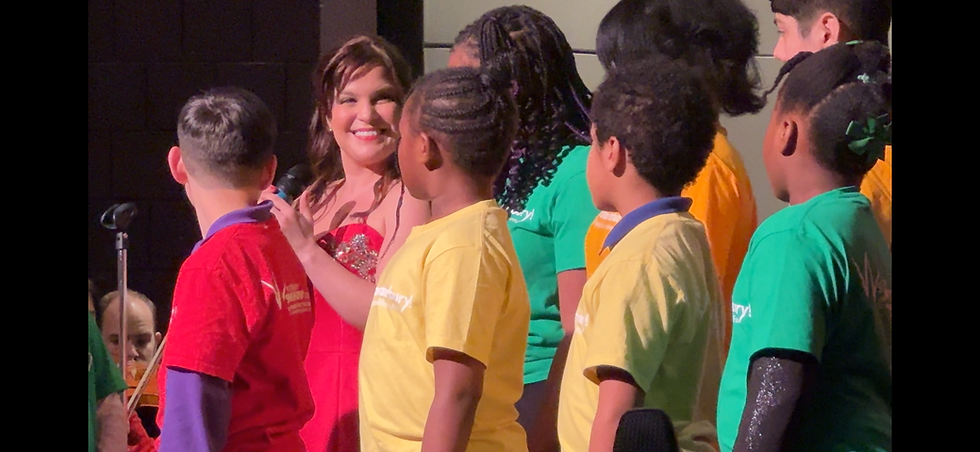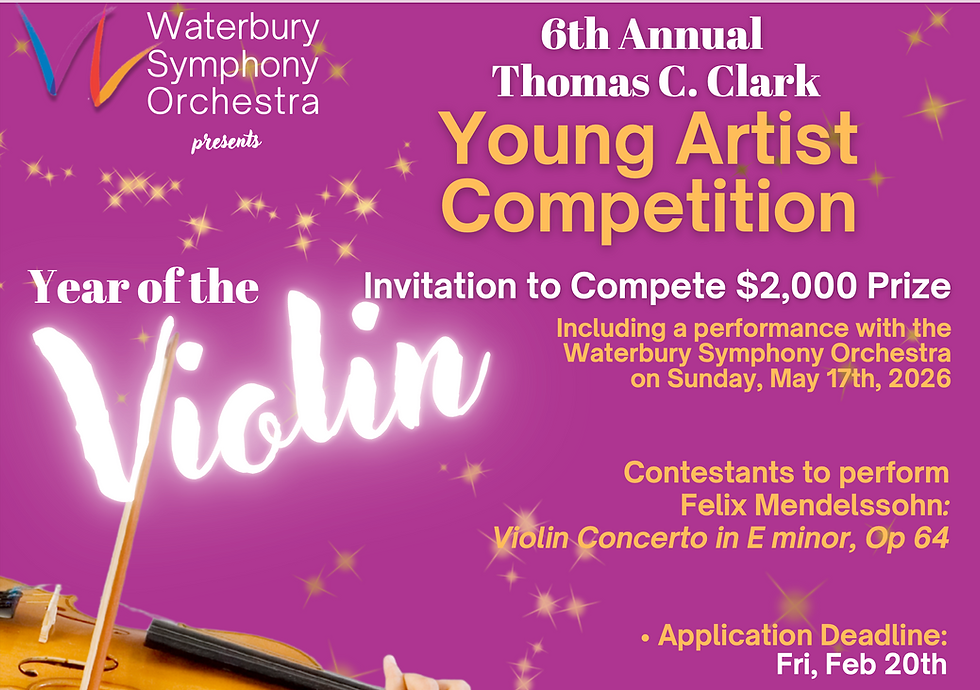Noted author, Charles Monagan explores the era underpinning the WSO's 'Concert of the Century'
- marketing7373
- Mar 1, 2024
- 6 min read
Updated: Mar 16, 2024
Forward by Leif Bjaland, Music Director/Conductor of the Waterbury Symphony Orchestra


As the Waterbury Symphony Orchestra (WSO) time-travels back to the music of 1924 for its “Concert of the Century,” one of the striking things about life 100 years ago is that music - all kinds of music - was suddenly everywhere and available to just about everyone. Music, as long as it was live, had always been an important feature of American life, of course. It had long rung out from churches, music halls, bandstands, opera houses or maybe it just kept low-key company by a campfire out on the range. But now, in the 1920s, it was pouring right into people’s homes as well. The piano in the parlor and its attendant piles of sheet music, long symbols of middle-class pride, were now being shoved aside by their shiny new cousins, phonograph records. And then records, which cost money, soon had to make room for music-happy radio, which was free.
Yet, this explosion in music was only a part of what was happening in America and the world as a whole, where a tectonic shift was at last signaling the real beginnings of the 20th century. As with most millennia, the 19th century had been reluctant to leave the stage. With a few notable exceptions, most books, music, fashion and social conventions retained a Victorian propriety. But World War I, with its vicious trench warfare and mustard gas, put an abrupt end to that, as did the attendant deadly flu pandemic of 1918-20. Once the dust cleared from those brutal events and a sort of peace and prosperity returned to the world, a far more carefree and unbuttoned “modern” era emerged. It was a faster, noisier time, too. The pace of life picked up. Technology made itself known. Automobiles crowded the city streets, delivery trucks put horses out to pasture, airplanes crossed the skies and train whistles echoed through the valleys. With their pounding factory rhythms, clacking streetcars, ringing office typewriters and piercing noontime whistles, now American cities plunged head-first into this new, fast-paced Mechanized Age. And along the way, its people embraced the many new leisure products and inventions of 1924 that signaled a break from the stick-in-the-mud past: Kleenex appeared on grocery shelves, as did Popsicles, Milky Ways and Band-Aids. Frozen vegetables were developed, as were dishwashers and a primitive television. Even the first cheeseburgers date to 100 years ago.
So what sort of music could possibly give life to the soundtrack for this global sea change? The WSO’s lineup for its “Concert of the Century” gives us an invigorating taste. First of all, it’s hard to miss the emergence of jazz and blues as influences. Record sales of about 100 million in 1924 meant music lovers were hearing types of music they never had the opportunity to hear before except maybe in a live setting. Popular Jazz Age artists of the day included Jelly Roll Morton, Bessie Smith, Paul Whiteman and Louis Armstrong. The music wasn’t to the taste of everyone, including many newspaper music critics, but as Irving Berlin put it, jazz had become the “rhythmic beat of our everyday lives.”
The WSO’s first offering from 1924, Arthur Honegger’s “Pacific 231,” takes one of the era’s recurring symbols of progress and power, the steam locomotive, and gives it a life in music. It’s a brief train ride that Honegger takes us on, but it’s all syncopation and forward movement. There are even passages that wouldn’t be out of place in Gershwin’s “Rhapsody in Blue,” including the abrupt braking to a noisy stop at the end. The steam locomotive was such a powerful representation of the modern world that it popped up everywhere in the arts back then, from Buster Keaton’s film “The General” to one of Duke Ellington’s early hits, “Choo Choo.” But Honegger, a Swiss national who spent many productive years in Paris, took his attraction to almost embarrassing heights. “I have always loved locomotives passionately,” he once said. “For me they are living creatures and I love them as others love women or horses.”
Also in Paris at the time, the quite modern woman who composed the WSO’s second piece, Germaine Tailleferre, left home and changed her last name after her father objected to her chosen career path. She found herself a friend and patron of the new music in Princess Edmond of Polignac. Tailleferre took part in the princess’s salons, where pianist Artur Rubinstein and the music of Stravinsky could be heard. Her own offering, “Concerto for Piano and Orchestra,” commissioned by the princess, was one of her earliest, and it manages to bridge old and new, being hailed as progressive by the critics. Listeners will hear echoes of Bach and Baroque but also feel the percussive energy of the new age. Tailleferre was a prolific composer, writing and performing (she often played the piano at concerts featuring her work) in Paris. At length, she was invited into the renowned circle of composers, including Honegger, known as Les Six, the only woman so honored.
The WSO’s centerpiece for its “Concert of the Century” journeys next to the States, with George Gershwin’s “Rhapsody in Blue,” commissioned by Paul Whiteman and premiered by him and his jazz band in February 1924 at Manhattan’s Aeolian Hall. Gershwin himself said he’d conceived of the piece “as a sort of musical kaleidoscope of America - of our vast melting pot, our incomparable national pep, our blues, our metropolitan madness.” He’d begun writing it only five weeks before its scheduled premiere, gaining inspiration during a train ride to Boston. “It was the train, with its steely rhythms, its rattle-ty bang, that is so often stimulating to a composer . . . I frequently hear music in the very heart of the noise.” From its opening clarinet glissando to its stirring climax, “Rhapsody” immediately won its way into audience’s hearts and onto the culture’s center stage. F. Scott Fitzgerald, a fellow chronicler of the age, felt the music idealized the youthful energy of the day, and he wasn’t alone. It’s hard to listen and not summon up the Manhattan of 1924, the skyline at dusk, the lights of Broadway, the theater marquees and hotel lobbies, the rumble of the subway, the rising steam, the car horns and doorman’s whistle, the Jazz Age hustle. Before long, the openness and optimism of “Rhapsody” was ringing out across America (more than a million copies of the first recording were sold) and around the world.
The WSO moves from modern to ultramodern, and something completely different, with its fourth 1924 selection, “Men and Mountains” by Carl Ruggles, described as one of America’s most iconoclastic, uncompromising composers. His ultramodernist, sometimes atonal approach (he called his music “granitic”) is very present in this piece, which breaks into three short passages - Men, Lilacs and Marching Mountains. The rough, insistent, nearly surrealistic rhythms of “Men” and “Marching Mountains” (which Ruggles said were inspired by William Blake’s “Great things are done when men and mountains meet.”) are mitigated in part by the middle passage, which is string-filled and relatively even-tempered. As to Ruggles himself, he was born on Cape Cod, spent most of his youthful years in New York and then moved to Vermont, where he seemed more content painting than composing music.
The concert’s final piece brings a return to conservatism in the new music of 1924, with Ottorino Respighi’s tone poem “Pines of Rome,”. Respighi was a native of Bologna who got to Rome in 1913 and was especially taken by the Eternal City’s fountains (which he depicted in a 1916 tone poem) and pine trees, which he said “spoke to my imagination above all.” “Pines of Rome,” first performed in 1924, consists of four movements, each depicting a setting in Rome known for its umbrella-like pines: the Villa Borghese gardens, near a catacomb, Janiculum Hill and the Appian Way. Each conjures its own mood, time of day and period in Roman life and history - nursery rhymes and children at play at Villa Borghese, a midday dirge at the catacomb, a moonlit nocturne (with nightingale) at Janiculum Hill, and the stirring return of triumphant Roman legions along the Appian Way. The massing of chords of the final movement will try to wipe out all your thoughts of modern music and the Jazz Age that preceded it, but it does demonstrate the wide world of music that was being produced 100 years ago - music that lives on to this day.
We can only wonder what sort of program the WSO might mount 100 years from now on the music first appearing in 2024. It might make for a good conversation over a post-concert drink.
About Charles Monagan: [As shared from cthumanities.org]
Charles Monagan has been a writer and editor since 1972, when he graduated from Dartmouth College. His work has appeared in many magazines and newspapers. From 1989 to 2013, he was the editor of Connecticut Magazine. In 1997, he was awarded the Gold Medal for Reporting from the national City and Regional Magazine Association. In 2012, he received the Connecticut Press Club’s Mark Twain Award for Distinguished Journalism, a lifetime award.
Monagan is the author of 10 books, including The Neurotic’s Handbook, The Reluctant Naturalist, and How to Get a Monkey into Harvard. Additionally, he wrote the book and lyrics for the musical Mad Bomber, which was produced in 2011 and won first place in the Academy for New Musical Theatre’s 2012 international Search for New Musicals.
Monagan’s most recent books are Carrie Welton (2016), a novel, which was a semifinalist for the international J.J. Bennetts Award for historical fiction, and Connecticut Icons (2017). Click here to visit his website. He lives in Middlebury, Connecticut, with his wife, Marcia.
Over the years Charles has written a wonderful and witty blog on his website: https://www.charlesmonagan.com



